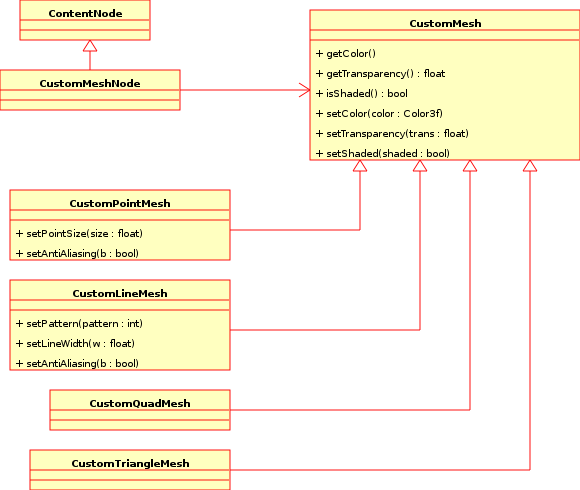The content of this page has not been vetted since shifting away from MediaWiki. If you’d like to help, check out the how to help guide!
How to display and show custom surfaces
You can download example source code for this HowTo here.
Before reading this HowTo, it may be helpful to read The relation between Content and Universe.
Simple meshes: lines, triangles, points, …
One strength of the viewer is to make displaying custom meshes very straightforward. User-defined points, lines, triangle or quadrangle meshes can be displayed very easily:
// Create a set of points
List<Point3f> mesh = new ArrayList<Point3f>();
mesh.add(new Point3f(-100, -100, 50));
mesh.add(new Point3f(100, -100, 50));
mesh.add(new Point3f(0, 100, 50));
// Create a universe and show it
Image3DUniverse univ = new Image3DUniverse();
univ.showAttribute(
Image3DUniverse.ATTRIBUTE_COORD_SYSTEM, false);
univ.show();
// Add the mesh as points
CustomPointMesh cm = new CustomPointMesh(mesh);
cm.setColor(new Color3f(0, 1, 0));
univ.addCustomMesh(cm, "points");
cm.setPointSize(10);
// Add the mesh as a triangle
CustomTriangleMesh tm = new CustomTriangleMesh(mesh);
tm.setColor(new Color3f(0, 0, 1));
Content c = univ.addCustomMesh(tm, "triangle");
// Add the mesh as a triangle
mesh.add(new Point3f(mesh.get(0))); // to close the path
CustomLineMesh lm = new CustomLineMesh(
mesh, CustomLineMesh.CONTINUOUS);
lm.setColor(new Color3f(1, 0, 0));
univ.addCustomMesh(lm, "lines");
lm.setLineWidth(5);
lm.setPattern(CustomLineMesh.DASH);
// after adding the CustomMesh to the universe, we have a
// reference to the Content, which can be used for further
// modification
c.setTransparency(0.5f);
More complex meshes, like spheres, tubes, etc
There exist also convenience methods in ImageJ3DUniverse for adding custom meshes, so that it is not necessary create the CustomMesh oneself. The corresponding methods can be found below.
To create more complex meshes, one can use the helper methods of the class Mesh_Maker:
// Use Mesh_Maker to create more complex surfaces like spheres,
// tubes or discs:
// define a sphere with center at the origin and radius 50
double x = 0, y = 0, z = 30, r = 50;
int meridians = 24;
int parallels = 24;
mesh = Mesh_Maker.createSphere(x, y, z, r, meridians, parallels);
Color3f color = null;
univ.addTriangleMesh(mesh, color, "sphere");
Display many surfaces efficiently
Assume for example that one would wish to display 1000 spheres together. One could of course add each sphere individually, but there is a more efficient way:
One can use Mesh_Maker to create a mesh for each of these spheres, and concatenate the resulting lists, so that one obtains one big list, which can then be added as one CustomMesh (in case of spheres this would be a CustomTriangleMesh).
This works only if the type of all the meshes is the same; one can not combine line meshes with point meshes, for example.
There is also another disadvantage; adding each sphere individually means that each sphere is represented as an individual Content, whose attributes can be changed separately. Adding all the spheres as a combined mesh will result in only one Content, whose attributes will affect all the spheres.
The class hierarchy of the customnode package
CustomMeshNode extends ContentNode, and therefore implements all the abstract methods in ContentNode. It has a reference to CustomMesh, which is an abstract class, implemented by CustomPointMesh, CustomLineMesh, CustomTriangleMesh and CustomQuadMesh.
Full control over custom nodes
CustomMesh implements the basic functions, as well as a default Java3D Appearance object, which is used in the subclasses. Since CustomMesh extends the Shape3D class, it provides a methods setAppearance() and setGeometry(), which give Java3D-experienced users full control over the content of their CustomMeshNode.
Important methods
Image3DUniverse:
public Content addCustomMesh(CustomMesh mesh, String name);
public Content addLineMesh(List<Point3f> mesh, Color3f color, String name,
boolean strips);
public Content addPointMesh(List<Point3f> mesh, Color3f color, String name);
public Content addQuadMesh(List<Point3f> mesh, Color3f color, String name);
public Content addTriangleMesh(List<Point3f> mesh, Color3f color, String name);
CustomMesh:
The methods of CustomMesh are inherited by CustomLineMesh, CustomPointMesh,CustomTriangleMesh and CustomQuadMesh. They can be used next to similar functions which are provided by the Content class, once the wrapping Content is created, however, it is recommended to use the methods there.
public Color3f getColor();
public void setColor(Color3f color);
public float getTransparency();
public void setTransparency(float transparency);
public boolean isShaded();
public void setShaded(boolean b);
CustomLineMesh:
public void setPattern(int pattern);
public void setAntiAliasing(boolean b);
public void setLineWidth(float w);
CustomPointMesh:
public void setPointSize(float pointsize);
public void setAntiAliasing(boolean b);
CustomTriangleMesh:
no additional methods.
CustomQuadMesh:
no additional methods.
Mesh_Maker:
static public List createSphere(double x, double y, double z, double r);
static public List createSphere(double x, double y, double z, double r,
int meridians, int parallels);
static public List createTube(double[] x, double[] y, double[] z,
double[] r, int parallels, boolean do_resample);
static public List createDisc(double x, double y, double z,
double nx, double ny, double nz,
double radius,
int edgePoints );
